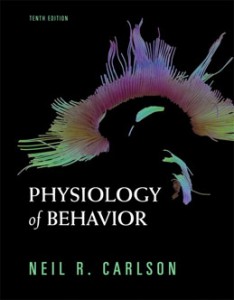Test Bank for Physiology of Behavior, 10th Edition: Carlson
$35.00 Original price was: $35.00.$26.50Current price is: $26.50.
Test Bank for Physiology of Behavior, 10th Edition: Carlson
Test Bank for Physiology of Behavior, 10th Edition: Carlson

Product details:
- ISBN-10 : 0205666272
- ISBN-13 : 978-0205666270
- Author: Neil Carlson, U Mass Amherst
The latest discoveries in the rapidly changing fields of neuroscience and physiological psychology are all incorporated in The Tenth Edition of Physiology of Behavior. This classic text continues its tradition as the most comprehensive, current, and teachable text for physiological psychology.
Table contents:
Chapter 1 Introduction 1
Chapter 2 Structure and Functions of Cells of the Nervous System 28
Chapter 3 Structure of the Nervous System 68
Chapter 4 Psychopharmacology 102
Chapter 5 Methods and Strategies of Research 134
Chapter 6 Vision 169
Chapter 7 Audition, the Body Senses, and the Chemical Sense 212
Chapter 8 Control of Movement 262
Chapter 9 Sleep and Biological Rhythms 295
Chapter 10 Reproductive Behavior 329
Chapter 11 Emotion 366
Chapter 12 Ingestive Behavior 400
Chapter 13 Learning and Memory 439
Chapter 14 Human Communication 485
Chapter 15 Neurological Disorders 520
Chapter 16 Schizophrenia and the Affective Disorders 554
Chapter 17 Anxiety Disorders, Autistic Disorder, Attention-Deficit/Hyperactivity Disorder, and Stress Disorders 585
Chapter 18 Drug Abuse 613
Detailed Table of Contents
Chapter 1 Introduction 1
UNDERSTANDING HUMAN CONSCIOUSNESS: A PHYSIOLOGICAL APPROACH
Blindsight 4
Split Brains 4
Unilateral Neglect 7
Interim Summary 9
THE NATURE OF PHYSIOLOGICAL PSYCHOLOGY 9
The Goals of Research 10
Biological Roots of Physiological Psychology 10
Interim Summary 14
NATURAL SELECTION AND EVOLUTION 14
Functionalism and the Inheritance of Traits 14
Evolution of the Human Species 17
Evolution of Large Brains 20
Interim Summary 22
ETHICAL ISSUES IN RESEARCH WITH ANIMALS 23
CAREERS IN NEUROSCIENCE 24
Interim Summary 25
STRATEGIES FOR LEARNING 26
SUGGESTED READINGS 27
ADDITIONAL RESOURCES 27
Chapter 2 Structure and Functions of Cells of the Nervous System 28
CELLS OF THE NERVOUS SYSTEM 30
Neurons 30
Supporting Cells 36
The Blood-Brain Barrier 40
Interim Summary 41
COMMUNICATION WITHIN A NEURON 42
Neural Communication: An Overview 42
Measuring Electrical Potentials of Axons 43
The Membrane Potential: Balance of Two Forces 45
The Action Potential 47
Conduction of the Action Potential 49
Interim Summary 52
COMMUNICATION BETWEEN NEURONS 53
Structure of Synapses 53
Release of Neurotransmitter 55
Activation of Receptors 57
Postsynaptic Potentials 59
Termination of Postsynaptic Potentials 60
Effects of Postsynaptic Potentials: Neural Integration 62
Autoreceptors 62
Other Types of Synapses 63
Nonsynaptic Chemical Communication 64
Interim Summary 66
SUGGESTED READINGS 67
ADDITIONAL RESOURCES 67
Chapter 3 Structure of the Nervous System 68
BASIC FEATURES OF THE NERVOUS SYSTEM 69
An Overview 72
Meninges 72
The Ventricular System and Production of CSF 73
Interim Summary 76
THE CENTRAL NERVOUS SYSTEM 76
Development of the Central Nervous System 77
The Forebrain 82
The Midbrain 91
The Hindbrain 93
The Spinal Cord 94
Interim Summary 95
THE PERIPHERAL NERVOUS SYSTEM 96
Spinal Nerves 96
Cranial Nerves 97
The Autonomic Nervous System 97
Interim Summary 101
SUGGESTED READINGS 101
ADDITIONAL RESOURCES 101
Chapter 4 Psychopharmacology 102
PRINCIPLES OF PSYCHOPHARMACOLOGY 104
Pharmacokinetics 104
Drug Effectiveness 107
Effects of Repeated Administration 108
Placebo Effects 109
Interim Summary 110
SITES OF DRUG ACTION 110
Effects on Production of Neurotransmitters 111
Effects on Storage and Release of Neurotransmitters 111
Effects on Receptors 112
Effects on Reuptake or Destruction of Neurotransmitters 113
Interim Summary 114
NEUROTRANSMITTERS AND NEUROMODULATORS 114
Acetylcholine 115
The Monamines 118
Amino Acids 124
Peptides 127
Lipids 128
Nucleosides 130
Soluble Gases 130
Interim Summary 131
SUGGESTED READINGS 133
ADDITIONAL RESOURCES 133
Chapter 5 Methods and Strategies of Research 134
EXPERIMENTAL ABLATION 136
Evaluating the Behavioral Effects of Brain Damage 136
Producing Brain Lesions 136
Stereotaxic Surgery138
Histological Methods 139
Tracing Neural Connections 143
Studying the Structure of the Living Human Brain 146
Interim Summary 149
RECORDING AND STIMULATING NEURAL ACTIVITY 151
Recording Neural Activity 151
Recording the Brain’s Metabolic Activity 153
Stimulating Neural Activity 155
Interim Summary 159
NEUROCHEMICAL METHODS 160
Finding Neurons That Produce Particular Neurochemicals 160
Localizing Particular Receptors 162
Measuring Chemicals Secreted in the Brain 163
Interim Summary 164
GENETIC METHODS 165
Twin Studies 166
Adoption Studies 166
Targeted Mutations 166
Antisense Oligonucleotides 167
Interim Summary 167
SUGGESTED READINGS 167
ADDITIONAL RESOURCES 168
Chapter 6 Vision 169
THE STIMULUS 171
ANATOMY OF THE VISUAL SYSTEM 172
The Eyes 172
Photoreceptors 174
Connections Between Eye and Brain 176
Interim Summary 178
CODING OF VISUAL INFORMATION IN THE RETINA 179
Coding of Light and Dark 179
Coding of Color 181
Interim Summary 185
ANALYSIS OF VISUAL INFORMATION: ROLE OF THE STRIATE CORTEX 186
Anatomy of the Striate Cortex 186
Orientation and Movement 186
Spatial Frequency 187
Retinal Disparity 189
Color 189
Modular Organization of the Striate Cortex 190
Interim Summary 191
ANALYSIS OF VISUAL INFORMATION: ROLE OF THE VISUAL ASSOCIATION CORTEX 192
Two Streams of Visual Analysis 192
Perception of Color 195
Perception of Form 196
Perception of Movement 202
Perception of Spatial Location 206
Interim Summary 209
SUGGESTED READINGS 211
ADDITIONAL RESOURCES 211
Chapter 7 Audition, the Body Senses, and the Chemical Sense 212
AUDIITON 212
The Stimulus 212
Anatomy of the Ear 214
Auditory Hair Cells and the Transduction of Auditory Information 216
The Auditory Pathway 218
Perception of Pitch 221
Perception of Loudness 224
Perception of Timbre 224
Perception of Spatial Location 225
Perception of Complex Sounds 229
Interim Summary 233
VESTIBULAR SYSTEM 234
Anatomy of the Vestibular Apparatus 234
The Receptor Cells 235
The Vestibular Pathway 235
Interim Summary 237
SOMATOSENSES 237
The Stimuli 237
Anatomy of the Skin and Its Receptive Organs 238
Perception of Cutaneous Stimulation 238
The Somatosensory Pathways 242
Perception of Pain 243
Interim Summary 248
GUSTATION 250
The Stimuli 250
Anatomy of the Taste Buds and Gustatory Cells 250
Perception of Gustatory Information 251
The Gustatory Pathway 253
Interim Summary 254
OLFACTION 255
The Stimulus 255
Anatomy of the Olfactory Apparatus 255
Transduction of Olfactory Information 257
Perception of Specific Odors 257
Interim Summary 260
SUGGESTED READINGS 260
ADDITIONAL RESOURC ES 261
Chapter 8 Control of Movement 262
MUSCLES 263
Skeletal Muscle 263
Smooth Muscle 266
Cardiac Muscle 267
Interim Summary 267
REFLEXIVE CONTROL OF MOVEMENT 268
The Monosynaptic Stretch Reflex 268
The Gamma Motor System 270
Polysynaptic Reflexes 270
Interim Summary 272
CONTROL OF MOVEMENT BY THE BRAIN 272
Organization of the Motor Cortex 273
Cortical Control of Movement: The Descending Pathways 274
Planning and Initiating Movements: Role of the Motor Association Cortex 277
Imitating and Comprehending Movements: Role of the Mirror Neuron System 280
Control of Reaching and Grasping 283
Deficits of Skilled Movements: The Apraxias 284
The Basal Ganglia 285
The Cerebellum 289
The Reticular Formation 292
Interim Summary 293
SUGGESTED READINGS 294
ADDITONAL RESOURCES 294
Chapter 9 Sleep and Biological Rhythms 295
A PHYSIOLOGICAL AND BEHAVIORAL DESCRIPTION OF SLEEP 295
Stages of Sleep 295
Mental Activity During Sleep 300
Interim Summary 301
DISORDERS OF SLEEP 301
Insomnia 301
Narcolepsy 302
REM Sleep Behavior Disorder 304
Problems Associated with Slow-Wave Sleep 304
Interim Summary 305
WHY DO WE SLEEP? 306
Functions of Slow-Wave Sleep 306
Functions of REM Sleep 308
Sleep and Learning 309
Interim Summary 310
PHYSIOLOGICAL MECHANISMS OF SLEEP AND WAKING 311
Chemical Control of Sleep 311
Neural Control of Arousal 312
Neural Control of Slow-Wave Sleep 314
Neural Control of REM Sleep 317
Interim Summary 320
BIOLOGICAL CLOCKS 321
Circadian Rhythms and Zeitgebers 321
The Suprachiasmatic Nucleus 322
Control of Seasonal Rhythms: The Pineal Gland and Melatonin 326
Changes in Circadian Rhythms: Shift Work and Jet Lag 327
Interim Summary 328
SUGGESTED READINGS 328
SUGGESTED READINGS 328
Chapter 10 Reproductive Behavior 329
SEXUAL DEVELOPMENT 330
Production of Gametes and Fertilization 330
Development of the Sex Organs 331
Sexual Maturation 334
Interim Summary 336
HORMONAL CONTROL OF SEXUAL BEHAVIOR 337 Hormonal Control of Female Reproductive Cycles 338
Hormonal Control of Sexual Behavior of Laboratory Animals 338
Organizational Effects of Androgens on Behavior: Masculinization and Defeminization 340
Effects of Pheromones 341
Human Sexual Behavior 344
Sexual Orientation 346
Interim Summary 352
NEURAL CONTROL OF SEXUAL BEHAVIOR 353
Males 353
Females 355
Formation of Pair Bonds 358
Interim Summary 359
PARENTAL BEHAVIOR 360
Maternal Behavior of Rodents 360
Hormonal Control of Maternal Behavior 361
Neural Control of Maternal Behavior 362
Neural Control of Paternal Behavior 364
Interim Summary 364
SUGGESTED READINGS 365
ADDITIONAL RESOURCES 365
Chapter 11 Emotion 366
EMOTIONS AS RESPONSE PATTERNS 367
Fear 368
Anger, Aggression, and Impulse Control 372
Hormonal Control of Aggressive Behavior 380
Interim Summary 384
COMMUNICATION OF EMOTIONS 385
Facial Expression of Emotions: Innate Responses 385
Neural Basis of the Communication of Emotions: Recognition 386
Neural Basis of the Communication of Emotions: Expression 391
Interim Summary 395
FEELINGS OF EMOTIONS 396
The James-Lange Theory 396
Feedback from Simulated Emotions 397
Interim Summary 399
SUGGESTED READINGS 399
ADDITIONAL RESOURCES 399
Chapter 12 Ingestive Behavior 400
People also search:
Physiology of Behavior
Physiology of Behavior Carlson
Physiology of Behavior Carlson 10th
Physiology of Behavior Carlson 10th Test Bank
Test Bank for Physiology of Behavior, 10th Edition: Carlson Download
Related products
Test Bank
Test Bank for Essentials of Business Law and the Legal Environment, 11th Edition: Richard A. Mann
Test Bank
Test Bank for Decision Support and Business Intelligence Systems, 9th Edition: Efraim Turban











